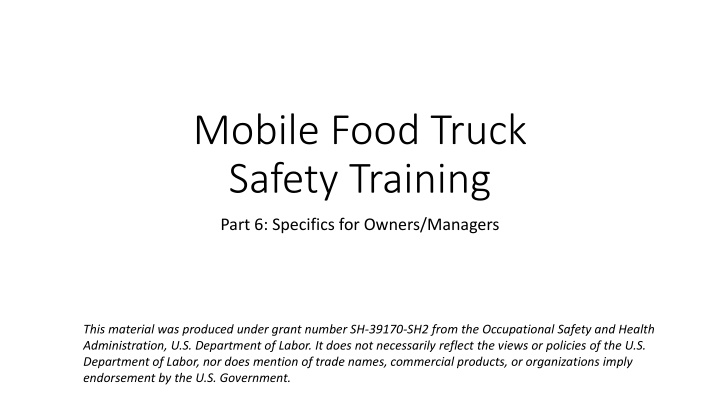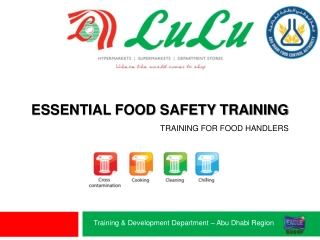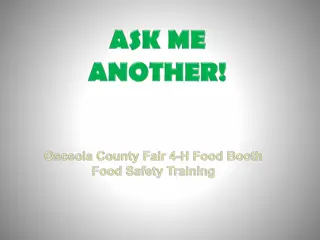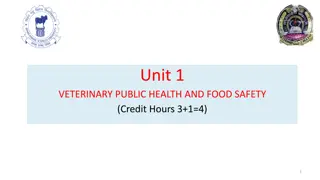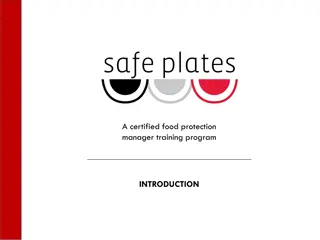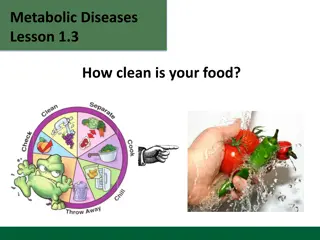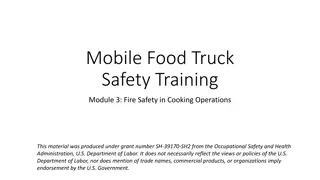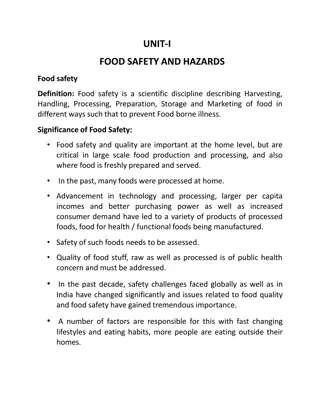Mobile Food Truck Safety Training for Owners/Managers
This material covers specific guidelines and resources for owners/managers of mobile food trucks to develop proactive safety programs. It emphasizes the importance of safety management mindset, compliance with regulations, and accessing OSHA assistance programs.
Download Presentation

Please find below an Image/Link to download the presentation.
The content on the website is provided AS IS for your information and personal use only. It may not be sold, licensed, or shared on other websites without obtaining consent from the author.If you encounter any issues during the download, it is possible that the publisher has removed the file from their server.
You are allowed to download the files provided on this website for personal or commercial use, subject to the condition that they are used lawfully. All files are the property of their respective owners.
The content on the website is provided AS IS for your information and personal use only. It may not be sold, licensed, or shared on other websites without obtaining consent from the author.
E N D
Presentation Transcript
Mobile Food Truck Safety Training Part 6: Specifics for Owners/Managers This material was produced under grant number SH-39170-SH2 from the Occupational Safety and Health Administration, U.S. Department of Labor. It does not necessarily reflect the views or policies of the U.S. Department of Labor, nor does mention of trade names, commercial products, or organizations imply endorsement by the U.S. Government.
Objectives After this module, the trainee will be able to: Recognize the benefits of having a proactive safety program Find resources to develop their own Health and Safety Plans for their workplaces
Today may have a lot of information Past accidents may scare you OSHA may scare you Future lawsuits may scare you But you have an opportunity to keep those from happening! If you can t be a good example, you may have to be a terrible warning. Catherine Aird You have already taken the first step to improving the safety of your business by attending this course! Keep the momentum going!
Safety Management Mindset Where are OSHA standards (and others)? If your only goal is compliance, how easy is it to fall short? What are the consequences? Safety Culture Spectrum Ideal- Sustained Safety Culture Best Practices- Highest Efficiency, Health, Safety Beyond Compliance- Improved working conditions Where are you on this scale today? Can workers bring problems to you, knowing they will be addressed? Is there a tendency to be proactive or reactive? What is your goal? How will you get there? What challenges/barriers exist? Compliance with Regulations Not Compliant with Regulations
OSHA provides small business assistance https://www.osha.gov/smallbusiness
OSHAs On-Site Consultation Program, SHARP https://www.osha.gov/complianceassistance/cas Assistance is available from Compliance Assistance Specialists OSHA s website has many resources for small businesses After you get started, you may want to request assistance for more complicated topics https://www.osha.gov/consultation Free Worker Safety/Health consulting services to small businesses Consulting services are separate from enforcement to assist employers on establishing, improving safety/health programs and achieving compliance
Sample Plans and Templates are Available *These will only work if you apply them to YOUR individual workplace* Emergency Action Plans (EAPs): OSHA e-Tool to create your own OSHA Sample EAP Template Fire Prevention Plans: OSHA e-Tool Sample Fire Prevention Plan Template (NC DOL) Additional plans are available but may depend on your company s needs and actual hazards present (i.e. Hazard Communication, Bloodborne Pathogens, etc)
Checklists for Fire Safety, Propane, Fire Extinguishers https://www.nfpa.org/Codes-and-Standards/Resources/Standards- in-action/Food-truck-safety You should also check your local jurisdictions- even if they have not updated their fire codes yet, they may sometime in the future By being proactive, you can be ahead of changes when they occur You can also be a leader in promoting safer work practices with your colleagues- many of them may be neighbors at a future event!
Employer Requirements for Training Employers must provide training to employees on the hazards present at the worksite. Ensure that workers are trained on: Proper procedures for emergencies (Emergency Action Plan) Proper procedure for notifying the fire department The fire hazards that are present and how to control them Proper method of shutting off fuel sources Proper procedure to perform leak test on gas connections Proper use of portable fire extinguishers and extinguishing systems Any other hazards that may affect them in the workplace If there is not documentation that training occurred, then it didn t happen. Keep written records of trainings and other important checks that may back you up if an accident does happen.
Additional Topics that May Apply Hazard Communication Standards Chemicals with Safety Data Sheets (SDSs) including cleaning chemicals Bloodborne Pathogens (BBP) Is there potential exposure to blood or other bodily fluids during an accident? How will this be handled? OSHA Recordkeeping This requirement may depend on the size of your company, how many employees you have
Summary Employers have several requirements to provide a safe workplace for their workers OSHA recognizes that small businesses have limited resources, offer their consultative services as assistance Conclusion: Resources are available to help you make your workplace a safe one for yourself and your workers. Take advantage of it and share your knowledge with others!
